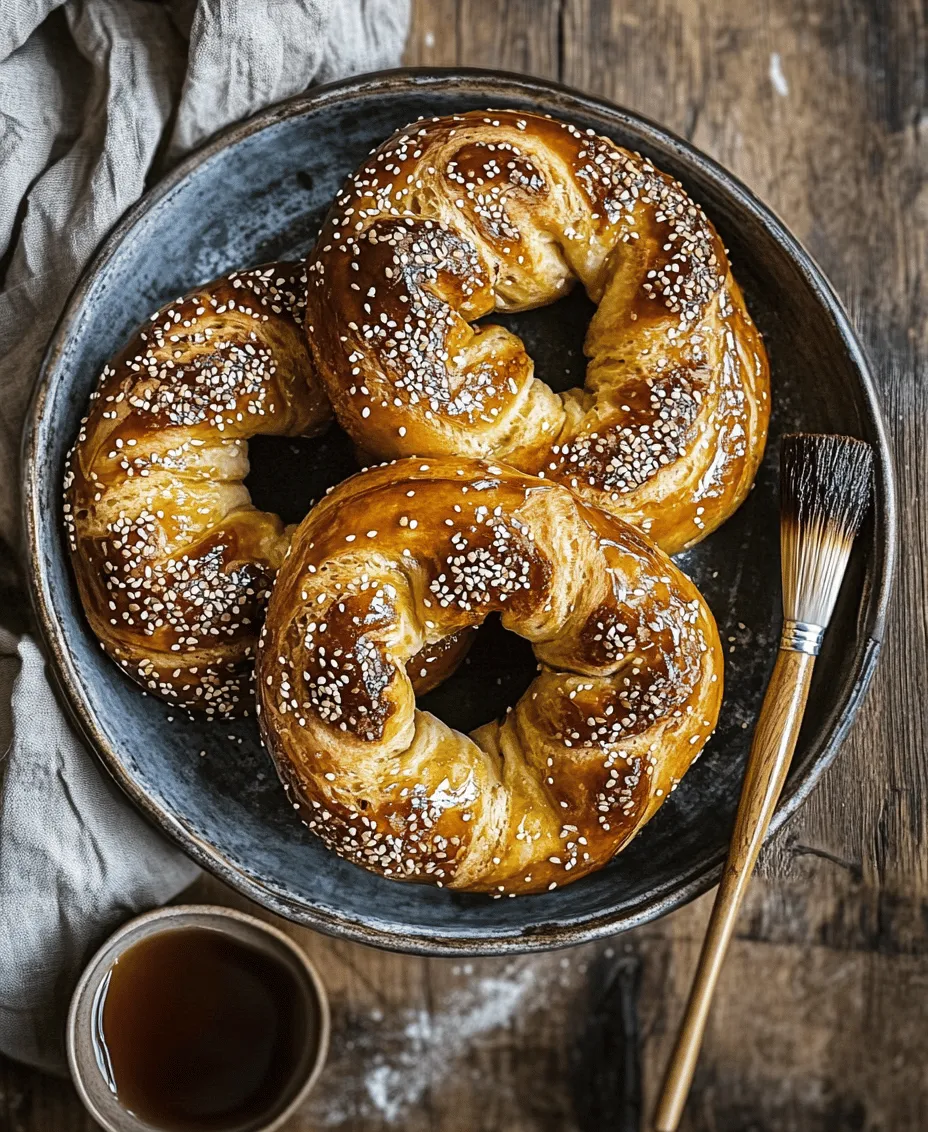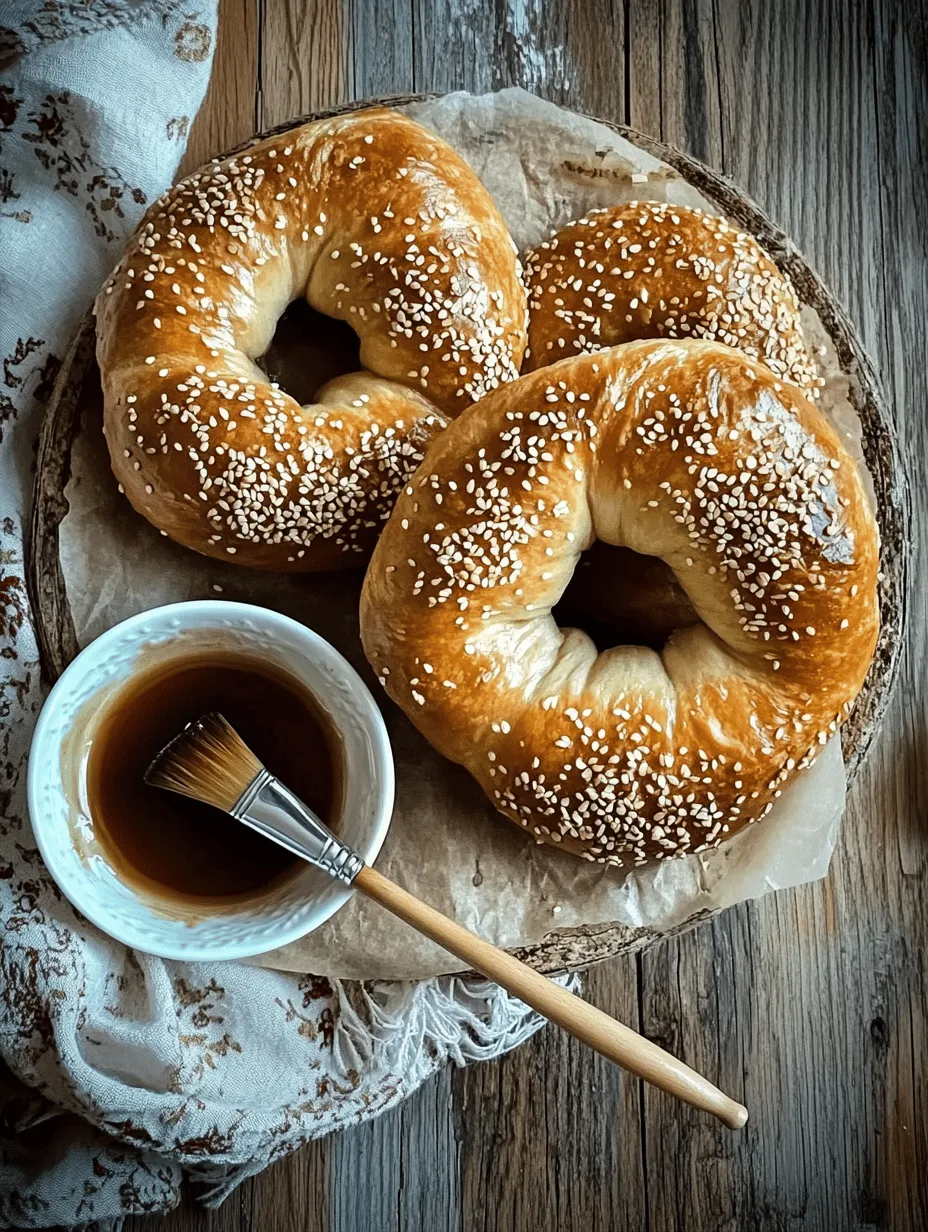Introduction
Simit, a beloved traditional bread in Egypt, serves as both a delicious snack and a hearty breakfast option. With its distinctive ring shape, golden crust, and generous coating of sesame seeds, it is a staple on Egyptian streets, often enjoyed on-the-go or at leisurely family breakfasts. The soft, chewy texture combined with its nutty flavor makes it an irresistible choice for many. In this article, we will explore the rich cultural significance of Golden Egyptian Simit, delve into its unique characteristics, and provide you with a detailed recipe along with preparation tips and serving suggestions that will elevate your baking experience.
Understanding Simit: A Cultural Perspective
The origins of Simit can be traced back centuries, with roots in various Middle Eastern and Mediterranean cuisines. In Egypt, this bread is not merely a food item; it is interwoven with the fabric of daily life. Traditionally, it is sold by street vendors, who often serve it freshly baked, enticing passersby with the aroma of warm bread and toasted sesame seeds. This bread is more than just a snack; it is often paired with creamy cheeses, olives, or even a simple spread of butter, making it a versatile option for any meal.
Interestingly, Simit is not exclusive to Egypt. Variations of this bread can be found in neighboring countries, with Turkish Simit being the most notable example. While Turkish Simit is characterized by its thicker crust and slightly sweeter flavor, the Egyptian version holds its own with a unique chewy texture and a generous sesame seed coating. The differences in preparation and serving styles highlight the cultural significance of bread in the region, showcasing how a simple ingredient can bring diverse communities together.
In Egypt, Simit is often enjoyed during casual gatherings and celebrations, symbolizing hospitality and sharing. Whether it’s served at breakfast alongside a cup of tea or as a late-night snack, Simit holds a special place in the hearts of many Egyptians.
Ingredients Breakdown
To create the perfect Golden Egyptian Simit, you’ll need a selection of essential ingredients. Each component plays a pivotal role in achieving the desired texture, flavor, and overall quality of the bread. Here’s a breakdown of what you’ll need:
– All-Purpose Flour: The foundation of any bread recipe, all-purpose flour provides the necessary structure and elasticity. Its protein content allows the dough to rise and develop a chewy texture, which is characteristic of Simit.
– Instant Yeast: This ingredient is crucial for the dough’s rise. Instant yeast allows for a quicker fermentation process, resulting in a light and airy texture. It’s important to note that proper activation of the yeast is essential to ensure a successful rise.
– Salt: Beyond its role in flavor enhancement, salt strengthens the gluten structure in the dough. It also helps to control fermentation, ensuring that the yeast works effectively without becoming too overpowering.
– Sugar: Sugar not only adds a hint of sweetness but also aids in browning the crust as the Simit bakes. It feeds the yeast during fermentation, contributing to the overall flavor and texture of the bread.
– Lukewarm Water: The temperature of the water is vital for activating the yeast. Water that is too hot may kill the yeast, while water that is too cold can hinder its activation. The ideal temperature is around 110°F (43°C), which creates the perfect environment for yeast to thrive.
– Olive Oil: Adding richness and moisture, olive oil helps create a tender crumb in the Simit. It also contributes to the flavor profile, giving the bread a subtle fruity note that pairs beautifully with the sesame seeds.
– Sesame Seeds: A defining characteristic of Golden Egyptian Simit, sesame seeds provide a nutty flavor and delightful crunch. They are also packed with nutritional benefits, including healthy fats, protein, and essential minerals.
– Molasses (or Honey): This ingredient is used to create the signature glaze on the Simit. Molasses adds a rich sweetness and enhances the depth of flavor, ensuring that each bite is deliciously satisfying.
– Cold Water: Used for the final glaze, cold water helps to create a shiny, appealing finish on the Simit. The contrast between the warm bread and the cold glaze enhances the overall texture and visual appeal.
Step-by-Step Instructions to Craft Golden Egyptian Simit
Preparation of the Dough
Creating a batch of Golden Egyptian Simit begins with preparing the dough. Follow these step-by-step instructions to ensure a successful result:
1. Mixing Dry Ingredients: Start by combining the all-purpose flour, instant yeast, sugar, and salt in a large mixing bowl. It is crucial to evenly distribute the dry ingredients to ensure that the yeast activates uniformly. Use a whisk or a fork to mix the ingredients thoroughly, allowing the flavors to meld.
2. Incorporating Water and Olive Oil: Gradually add lukewarm water to the dry mixture while stirring with a wooden spoon or your hands. The goal is to incorporate the water evenly without creating lumps. Once the dough begins to form, add the olive oil and continue mixing until fully combined.
3. Kneading the Dough: Transfer the dough onto a lightly floured surface. Knead the dough for about 8-10 minutes, or until it becomes smooth and elastic. The kneading process is essential as it develops the gluten structure, which contributes to the chewy texture of the Simit.
4. First Rise: After kneading, shape the dough into a ball and place it in a greased bowl. Cover the bowl with a clean kitchen towel or plastic wrap, and let it rise in a warm, draft-free area for approximately 1-2 hours, or until it has doubled in size. This fermentation stage is crucial for achieving a light and airy texture.
5. Shaping the Simit: Once the dough has risen, gently punch it down to release the air. Divide the dough into equal portions, typically around 8-10 pieces, depending on the desired size of your Simit. Roll each piece into a long rope, about 12 inches in length, and then shape it into a ring by pinching the ends together.
6. Preparing for the Glaze: To create the signature glaze, combine molasses (or honey) with cold water in a shallow dish. This mixture will give the Simit its beautiful sheen and enhance the flavor profile.
7. Coating with Sesame Seeds: Dip each Simit ring into the molasses mixture, allowing any excess to drip off. Then, roll the coated ring in sesame seeds, ensuring an even coverage. The sesame seeds not only add flavor but also create a visually appealing crust once baked.
8. Second Rise: Place the prepared Simit on a baking sheet lined with parchment paper. Cover them again and let them rest for an additional 30-45 minutes. This second rise will allow the dough to puff up slightly, ensuring a light and airy final product.
By meticulously following these steps, you will be well on your way to creating delicious Golden Egyptian Simit that embodies the rich culinary tradition of Egypt. The combination of flavors and textures will not only satisfy your taste buds but also connect you with a cherished cultural heritage. In the next section of this article, we will delve further into the baking process and explore some serving suggestions that will make your Simit experience truly unforgettable.

Kneading Techniques for Perfect Dough Consistency
Kneading is a critical step in the bread-making process, especially for creating Golden Egyptian Simit. The goal of kneading is to develop gluten, which gives the dough its structure and elasticity. To achieve the perfect consistency, follow these steps:
1. Hand Kneading: Start by combining your ingredients in a mixing bowl. Once they are roughly combined, transfer the mixture onto a floured surface. Use the heel of your hand to push the dough away from you, then fold it back over itself. Rotate the dough a quarter turn and repeat this process for about 10-15 minutes. The dough should become smooth and elastic.
2. Using a Stand Mixer: If you prefer a less labor-intensive method, a stand mixer can be used with a dough hook attachment. Mix the ingredients at low speed until they form a ball, then increase to medium speed for about 6-8 minutes. The dough should clean the sides of the bowl and become smooth.
3. Checking Consistency: The final dough should be slightly tacky but not sticky. If it sticks excessively to your hands, add a small amount of flour, but avoid adding too much, as this can lead to a dense bread.
The Rising Process
Once the dough has been kneaded to the right consistency, it’s time for the rising process, which is crucial for developing flavor and texture in the Simit.
Explanation of Proofing and Its Significance in Bread Making
Proofing, or the first rise, is when the yeast ferments, producing carbon dioxide that expands the dough. This step is essential as it allows the flavors to develop and the gluten to relax, making the dough easier to shape.
Ideal Conditions for Dough Rising (Temperature and Time)
For optimal proofing, place your dough in a warm, draft-free area. The ideal temperature for yeast activity is between 75°F to 80°F (24°C to 27°C). Cover the dough with a damp cloth or plastic wrap to retain moisture. Allow it to rise for about 1 to 1.5 hours, or until it doubles in size.
Shaping the Simit
After the dough has risen, it’s time to shape the Simit. This is where the fun begins!
Techniques for Forming Ropes and Twisting
1. Dividing the Dough: Gently punch down the risen dough to release any excess air. Divide the dough into equal pieces, typically around 8-10 portions, depending on your desired size.
2. Forming Ropes: Roll each portion into a long rope, approximately 12-14 inches long. Ensure that the rope is even in thickness for uniform baking.
3. Twisting: To create the signature shape of Simit, take two ropes and twist them together, forming a circular shape. Pinch the ends together securely to ensure they do not unravel during baking.
Tips for Pinching Ends Securely to Maintain Shape During Baking
Ensure that the ends of the twisted dough are pinched tightly. You can also roll the ends on the counter for a few seconds to help seal them further. This will prevent the shape from loosening while baking.
Glazing and Sesame Coating
Now that your Simit is shaped, it’s time to prepare for the final touches before baking.
Detailed Process of Preparing the Glaze
A simple glaze can be made using a combination of water and molasses, which adds a rich flavor and helps the sesame seeds adhere. Follow these steps:
1. In a small bowl, mix 1/4 cup of warm water with 2 tablespoons of molasses until fully combined.
2. Dip each shaped Simit into the glaze, ensuring an even coating.
Importance of Sesame Seeds in Achieving Authentic Flavor and Crunch
Next, roll each glazed Simit in a plate filled with sesame seeds. The seeds not only provide a delightful crunch but also enhance the traditional flavor associated with Egyptian Simit. For a deeper flavor, consider toasting the sesame seeds lightly before use.
Baking the Simit
With the Simit shaped and coated, it’s time to bake!
Oven Preparation: Temperature Settings and Baking Sheet Preparation
Preheat your oven to 425°F (220°C). Line a baking sheet with parchment paper or lightly grease it to prevent sticking. Place the Simit on the sheet, ensuring they have enough space to expand during baking.
Signs to Look for to Ensure Perfect Baking (Color and Texture)
Bake the Simit for about 15-20 minutes, or until they turn a beautiful golden brown. Look for a crispy exterior and a hollow sound when tapped on the bottom. The texture should be firm yet soft inside.
Recommended Cooling Time for Optimal Taste and Texture
Once baked, remove the Simit from the oven and allow them to cool on a wire rack for at least 10 minutes. This cooling period helps preserve the texture and flavor before serving.
Serving Suggestions for Golden Egyptian Simit
Golden Egyptian Simit is best enjoyed fresh, but its versatility allows for a range of serving options.
Traditional Accompaniments: Dips, Spreads, and Beverages Commonly Enjoyed with Simit
Traditionally, Simit is served with a variety of dips and spreads. Consider pairing it with:
– Hummus: Creamy and flavorful, hummus complements the crunchy texture of Simit perfectly.
– Labneh: This tangy strained yogurt spread offers a refreshing contrast to the bread.
– Olive Oil and Za’atar: A drizzle of quality olive oil with a sprinkle of za’atar is a classic combination.
For beverages, serve your Simit alongside a cup of strong Turkish coffee or traditional Egyptian tea to enhance the experience.
Creative Serving Ideas for Modern Twists (e.g., Using Simit as a Sandwich Base)
For a modern twist, consider using Simit as a base for gourmet sandwiches. Fill it with:
– Smoked salmon and cream cheese: This combination brings a delightful richness to the table.
– Avocado and poached egg: An excellent brunch option that adds a nutritious touch.
Pairing Suggestions with Coffee or Tea
The nutty flavor of Simit pairs beautifully with coffee or tea. For coffee lovers, a strong espresso or a frothy cappuccino complements the bread’s texture and flavor. Tea drinkers may enjoy a fragrant mint tea or traditional Egyptian tea, both of which elevate the dining experience.
Nutritional Information
Golden Egyptian Simit not only delights the palate but also offers nutritional benefits when consumed mindfully.
Overview of the Nutritional Benefits of Simit
Made primarily from flour, water, yeast, and sesame seeds, Simit is a source of carbohydrates, healthy fats, and essential nutrients. The sesame seeds provide beneficial minerals, including calcium, iron, and magnesium.
Discussion on Portion Control and Healthy Eating Habits
While Simit is delicious, portion control is key. Enjoy it in moderation, especially if you’re watching your calorie intake. Pairing it with nutritious dips and spreads can enhance its health benefits, making it a wholesome part of a balanced diet.
Highlighting the Use of Wholesome Ingredients in This Recipe
By using high-quality ingredients such as whole wheat flour, natural yeast, and unrefined molasses, you can create a healthier version of Simit that is both delicious and nutritious. This attention to ingredient quality elevates the overall dish.
Conclusion
Golden Egyptian Simit is more than just a delightful bread; it is a cultural tradition that connects people through its rich history and flavors. With its crispy exterior and soft interior, it embodies the essence of Egyptian cuisine.
We encourage you to try this recipe at home and experience the joy of baking your own Simit. Not only will you savor the authentic taste of Egypt, but you’ll also create lasting memories with friends and family as you share this traditional bread. The process of making homemade bread brings people together, creating moments of joy and connection around the table. So gather your ingredients, roll up your sleeves, and embark on this culinary adventure!



